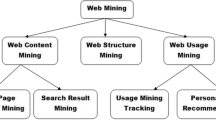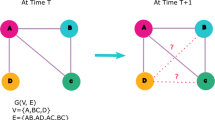Abstract
An important task in network modeling is the prediction of relationships between classes of objects, such as friendship between persons, preferences of users for items, or the influence of genes on diseases. Factorizing approaches have proven effective in the modeling of these types of relations. If only a single binary relation is of interest, matrix factorization is typically applied. For ternary relations, tensor factorization has become popular. A typical application of tensor factorization concerns the temporal development of the relationships between objects. There are applications, where models with n-ary relations with n > 3 need to be considered, which is the topic of this paper. These models permit the inclusion of context information that is relevant for relation prediction. Unfortunately, the straightforward application of higher-order tensor models becomes problematic, due to the sparsity of the data and due to the complexity of the computations. In this paper, we discuss two different approaches that both simplify the higher-order tensors using coupled low-order factorization models. While the first approach, the context-aware recommendation tensor decomposition (CARTD), proposes an efficient optimization criterion and decomposition method, the second approach, the context-aware regularized singular value decomposition (CRSVD), introduces a generative probabilistic model and aims at reducing the dimensionality using independence assumptions in graphical models. In this article, we discuss both approaches and compare their ability to model contextual information. We test both models on a social network setting, where the task is to predict preferences based on existing preference patterns, based on the last item selected and based on attributes describing items and users. The experiments are performed using data from the GetGlue social network and the approach is evaluated on the ranking quality of predicted relations. The results indicate that the CARTD is superior in predicting overall rankings for relations, whereas the CRSVD is superior when one is only interested in predicting the top-ranked relations.










Similar content being viewed by others
Notes
Normalization takes care that all entries are non-zero and are smaller than one. Incidentally, this step turns out to be unnecessary in the regularized reconstruction, since after matrix completion all entries already obeyed these constraints. A second step ensures that the sum over matrix entries is equal to one.
A link from the last movie to movie might appear more plausible. If one does that change, the link between user and movie would need to point from movie to user, such that no collider (more than one link pointing to the same node) appears. With a collider one would need to use a tensor model as a local model.
References
Ataman K, Nick W, Member S, Zhang Y (2006) Learning to rank by maximizing AUC with linear programming. In: IEEE international joint conference on neural networks (IJCNN)
Barbieri DF, Braga D, Ceri S, Valle ED, Grossniklaus M (2009) Continuous queries and real-time analysis of social semantic data with c-sparql. In: Second workshop on social data on the Web (SDoW2009)
Bell RM, Koren Y, Volinsky C (2010) All together now: a perspective on the netflix prize. Chance 23:24–29
Breese JS, Heckerman D, Kadie C (1998) Empirical analysis of predictive algorithms for collaborative filtering. In: Uncertainty in artificial intelligence
Cands EJ, Recht B (2008) Exact matrix completion via convex optimization. Computing research repository—CORR
Chu W, Ghahramani Z (2009) Probabilistic models for incomplete multi-dimensional arrays. In: AISTATS
Chu W, Sindhwani V, Ghahramani Z, Keerthi SS (2006) Relational learning with gaussian processes. In: NIPS
Domingos P, Richardson M (2007) Markov logic: a unifying framework for statistical relational learning. In: Getoor L, Taskar B (eds) Introduction to statistical relational learning, MIT Press, Cambridge
Getoor L, Friedman N, Koller D, Pferrer A, Taskar B (2007) Probabilistic relational models. In: Getoor L, Taskar B (eds) Introduction to statistical relational learning, MIT Press, Cambridge
Heckerman D, Chickering DM, Meek C, Rounthwaite R, Kadie CM (2000) Dependency networks for inference, collaborative filtering, and data visualization. J Mach Learn Res
Huang Y, Tresp V, Bundschus M, Rettinger A, Kriegel HP (2010) Multivariate structured prediction for learning on the semantic web. In: Proceedings of the 20th international conference on inductive logic programming (ILP)
Kemp C, Tenenbaum JB, Griffiths TL, Yamada T, Ueda N (2006) Learning systems of concepts with an infinite relational model. In: Proceedings of the national conference on artificial intelligence (AAAI)
Kolda TG, Bader BW (2009) Tensor decompositions and applications. SIAM Review
Koller D, Pfeffer A (1998) Probabilistic frame-based systems. In: Proceedings of the national conference on artificial intelligence (AAAI)
Koren Y (2009) Collaborative filtering with temporal dynamics. In: KDD ’09 proceedings of the 15th ACM SIGKDD international conference on knowledge discovery and data mining, ACM, New York
Lauritzen SL (1996) Graphical Models. Oxford Statistical Science Series
Linden G, Smith B, York J (2003) Amazon.com recommendations: item-to-item collaborative filtering. IEEE Internet Computing 7(1):76–80
Ling CX, Huang J, Zhang H (2003) Auc: a statistically consistent and more discriminating measure than accuracy. In: Proceedings of the 18th international joint conference on artificial intelligence, Morgan Kaufmann Publishers Inc., San Francisco, pp 519–524
Rendle S, Freudenthaler C, Gantner Z, Schmidt-Thieme L (2009) BPR: bayesian personalized ranking from implicit feedback. In: Proceedings of the 25th conference on uncertainty in artificial intelligence (UAI)
Rendle S, Freudenthaler C, Schmidt-Thieme L (2010) Factorizing personalized markov chains for next-basket recommendation. In: World Wide Web Conference
Salakhutdinov R, Mnih A (2007) Probabilistic matrix factorization. In: NIPS
Takacs G, Pilaszy I, Nemeth B, Tikk D (2007) On the gravity recommendation system. In: Proceedings of KDD cup and workshop 2007
Wermser H, Rettinger A, Tresp V (2011) Modeling and learning context-aware recommendation scenarios using tensor decomposition. In: International conference on advances in social networks analysis and mining (ASONAM 2011), IEEE CPS
Xu Z, Tresp V, Yu K, Kriegel HP (2006) Infinite hidden relational models. In: Uncertainty in artificial intelligence (UAI)
Yan L, Dodier R, Mozer M, Wolniewicz R (2003) Optimizing classifier performance via the Wilcoxon-Mann-Whitney statistics. In: Proceedings of the 20th international conference on machine learning
Yu K, Chu W, Yu S, Tresp V, Xu Z (2006) Stochastic relational models for discriminative link prediction. In: Advances in neural information processing systems 19
Author information
Authors and Affiliations
Corresponding author
Rights and permissions
About this article
Cite this article
Rettinger, A., Wermser, H., Huang, Y. et al. Context-aware tensor decomposition for relation prediction in social networks. Soc. Netw. Anal. Min. 2, 373–385 (2012). https://doi.org/10.1007/s13278-012-0069-5
Received:
Revised:
Accepted:
Published:
Issue Date:
DOI: https://doi.org/10.1007/s13278-012-0069-5




